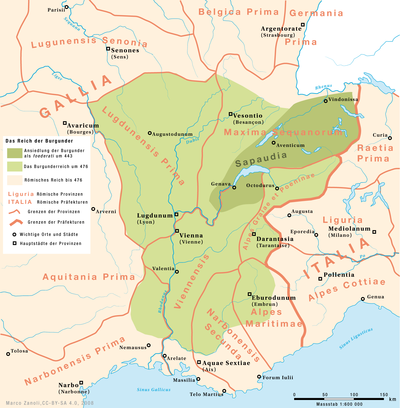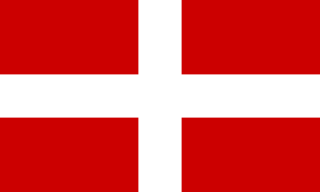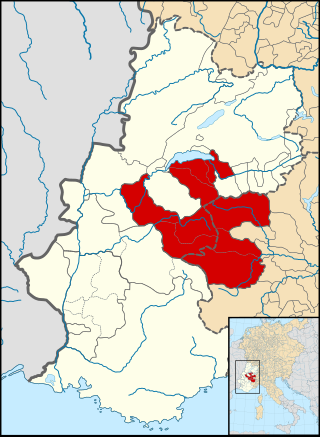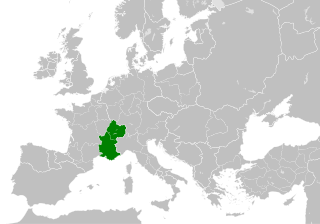
Sapaudia or Sabaudia was an Alpine territory of Late antiquity and the Dark Ages.

Sapaudia or Sabaudia was an Alpine territory of Late antiquity and the Dark Ages.
The name is a Latinisation of the local words for "forest" or "upland forest", although it is often glossed as "fir" from the roughly similar Latin sapinus. [1] It developed first into Saboia [2] and thence into Italian Savoia (Savoy; French : Savoie, Arpitan : Savouè). [1]
Sapaudia first appears [2] in mention by the 4th century late-Roman historian Ammianus Marcellinus, [3] who described it as the southern district of Provincia Maxima Sequanorum, the land of the Sequani enlarged by the Diocletian Reforms. It originally covered the area around Lake Neuchâtel, [1] . Its prefect appeared in the late Roman List of Offices .
During the 5th century, the Burgundians settled in the area, forming the Kingdom of the Burgundians, the capital of which was Geneva. For centuries thereafter, the names Burgundy and Sapaudia/Savoy became closely linked.
In the mid-9th century, Sapaudia was ruled by the Bosonid duke Hucbert as part of the realm of Upper Burgundy. In 933, it was incorporated into Rudolph II's Kingdom of Burgundy.
Humbert I was made count over the area by Rudolph III of Burgundy. For his support of Henry II, Holy Roman Emperor, he received the secular dignities of the bishop of Aosta as its new count following the death of Bishop Anselm. (Anselm's less supportive nephew Burchard was permitted to succeed to the diocese.)
Upon Rudolph's death in 1032, Humbert accepted Conrad II, Holy Roman Emperor's annexation of Arles and supported him in suppressing the revolts of Count Odo and Burchard. For this, he was rewarded with the county of Maurienne (carved out of the diocese of Vienne) and territory in Chablais and the Tarentaise Valley, carved from the diocese of Tarentaise at Moûtiers. This expanded territory became known as the county of Savoy.

Savoy is a cultural-historical region in the Western Alps.

Year 1032 (MXXXII) was a leap year starting on Saturday of the Julian calendar.

Humbert I, better known as Humbert the White-Handed or Humbert Whitehand, was the founder of the House of Savoy. Of obscure origins, his service to the Holy Roman Emperors Henry II and Conrad II was rewarded with the counties of Maurienne and Aosta and lands in Valais, all at the expense of local bishops and archbishops; the territory came to be known as the county of Savoy.

Amadeus V was Count of Savoy from 1285 to 1323.

The County of Savoy was a State of the Holy Roman Empire which emerged, along with the free communes of Switzerland, from the collapse of the Burgundian Kingdom in the 11th century. It was the cradle of the future Savoyard state.
Rudolph III, called the Idle or the Pious, was the king of Burgundy from 993 until his death. He was the last ruler of an independent Kingdom of Burgundy, and the last male member of the Burgundian group of the Elder House of Welf.

The Kingdom of Lower Burgundy, also called Cisjurane Burgundy, was a historical kingdom in what is now southeastern France, so-called because it was lower down the Rhône Valley than Upper Burgundy. It included some of the territory of the Kingdom of Arelat.

The Diocese of Sion is a Catholic ecclesiastical territory in the canton of Valais, Switzerland. It is the oldest bishopric in the country and one of the oldest north of the Alps. The history of the Bishops of Sion, of the Abbey of St. Maurice of Valais as a whole are inextricably intertwined.
Kingdom of Burgundy was a name given to various states located in Western Europe during the Middle Ages. The historical Burgundy correlates with the border area of France and Switzerland and includes the major modern cities of Geneva and Lyon.

The Kingdom of Burgundy, known from the 12th century as the Kingdom of Arles, also referred to in various context as Arelat, the Kingdom of Arles and Vienne, or Kingdom of Burgundy-Provence, was a realm established in 933 by the merger of the kingdoms of Upper and Lower Burgundy under King Rudolf II. It was incorporated into the Holy Roman Empire in 1033 and from then on was one of the empire's three constituent realms, together with the Kingdom of Germany and the Kingdom of Italy. By the mid-13th century at the latest, however, it had lost its concrete political relevance.

The Duchy of Swabia was one of the five stem duchies of the medieval German Kingdom. It arose in the 10th century in the southwestern area that had been settled by Alemanni tribes in Late Antiquity.

The Kingdom of Upper Burgundy was a Frankish dominion established in 888 by the Welf king Rudolph I of Burgundy on the territory of former Middle Francia. It grew out of the Carolingian margraviate of Transjurane Burgundy southeast of ('beyond') the Jura Mountains together with the adjacent County of Burgundy (Franche-Comté) in the northwest. The adjective 'upper' refers to its location further up the Rhône river, as distinct from Lower Burgundy and also from the Duchy of Burgundy west of the Saône river. Upper Burgundy was reunited with the Kingdom of Lower Burgundy in 933 to form the Kingdom of Burgundy, later known as Kingdom of Arles or Arelat.

The County of Geneva, largely corresponding to the later Genevois province, originated in the tenth century, in the Burgundian Kingdom of Arles (Arelat) which fell to the Holy Roman Empire in 1032.

The Archdiocese of Tarentaise was a Roman Catholic diocese and archdiocese in France, with its see in Moûtiers, in the Tarentaise Valley in Savoie. It was established as a diocese in the 5th century, elevated to archdiocese in 794, and disbanded in 1801. The diocese of Tarentaise was again formed in 1825, and united with the diocese of Chambéry and diocese of Saint-Jean-de-Maurienne to form the Archdiocese of Chambéry, Maurienne and Tarentaise in 1966.

The French Roman Catholic diocese of Saint-Jean-de-Maurienne has since 1966 been effectively suppressed, formally united with the archdiocese of Chambéry. While it has not been suppressed, and is supposed to be on a par with Chambéry and the diocese of Tarentaise, it no longer has a separate bishop or existence.
Burchard or Bouchard or Buckard or Burchard Aosta, was Bishop of Aosta (1025–1032) and Archbishop of Lyon (1033–1034), under the name of Burchard III, and finally prior of the territorial abbey of Saint Maurice. Burchard was a son of Humbert I, Count of Savoy and Aosta and his wife Auxilia, who may have originated from Aosta and who would have been the sister of Anselm of Aosta, bishop from 994–1025.
Ermengarde was a medieval noblewoman. Through her first marriage, to Rotbold II, Count of Provence, she was countess of Provence, and from 1011 to 1032 Ermengarde was the last queen of independent Burgundy by virtue of her second marriage to Rudolf III of Burgundy.
Aymon de Briançon was a Burgundian nobleman and Carthusian monk who served as the archbishop of Tarentaise from around 1175 until his death. From 1186, he was a prince of the Holy Roman Empire. He took part in the Third Crusade in 1189.